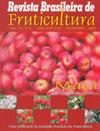Mapping Apple Orchards in the municipality of São Joaquim (Santa Catarina, Brazil) using Sentinel-2 data
IF 0.9
4区 农林科学
Q4 HORTICULTURE
引用次数: 0
Abstract
Abstract This study carried out a mapping procedure focusing on apple orchards considering the planted area, spatial location, altitude range, slope interval, and presence of anti-hail nets in the city of São Joaquim (Southern Santa Catarina Plateau, Brazil). Spectral images from the Sentinel-2 orbital platform acquired in August 2018 and an enhanced digital elevation model from the Shuttle Radar Topography Mission (SRTM) were used. In a GIS application configured with the SIRGAS 2000,4 reference system and UTM cartographic projection, Sentinel-2 constellation images and digital elevation models from the SRTM mission and more recently refined with sensor data Phased Array type L-band Synthetic Aperture Radar (PALSAR) were added. All images were resampled to a spatial resolution of 10m. The results were validated based on high spatial resolution images available from Google Earth. The results show that São Joaquim has a planted area of 7,974.80 ha, and only 12% use an anti-hail coverage system. The majority of the orchards range from one to five ha and belong to small producers. More than 50% of the orchards are between 1,200 and 1,400 m in altitude, with 45% of orchards located in areas with slopes between 8 to 20%. Interestingly, most of the orchards are concentrated in a radius of up to 20km from the urban center of São Joaquim, where industries and cooperatives are located for packaging, processing, and logistics. This study demonstrated that orbital data from Sentinel-2 can effectively quantify the distribution of apple orchards, being a viable and effective alternative for collecting information for agricultural monitoring. In this way, it enables efficient planning of apple production, such as technical assistance, marketing with producers, and production flow.利用Sentinel-2数据绘制巴西圣卡塔琳娜州s o Joaquim市苹果园地图
以巴西圣卡塔琳娜高原南部s o Joaquim市的苹果果园为研究对象,综合考虑种植面积、空间位置、海拔范围、坡距和防雹网的存在等因素,开展了以苹果果园为研究对象的制图工作。使用了2018年8月获得的哨兵2号轨道平台的光谱图像和航天飞机雷达地形任务(SRTM)的增强型数字高程模型。在使用SIRGAS 2000配置的GIS应用程序中,添加了4参考系统和UTM地图投影、Sentinel-2星座图像和SRTM任务的数字高程模型,以及最近使用相控阵型l波段合成孔径雷达(PALSAR)的传感器数据进行了改进。所有图像重新采样至10m的空间分辨率。基于谷歌地球提供的高空间分辨率图像对结果进行了验证。结果表明,s o Joaquim的种植面积为7,974.80 ha,只有12%使用防雹覆盖系统。大多数果园面积从1公顷到5公顷不等,属于小生产者。超过50%的果园海拔在1200米至1400米之间,45%的果园位于坡度在8%至20%之间的地区。有趣的是,大部分果园都集中在距离城市中心 o Joaquim 20公里的半径内,那里有工业和合作社,从事包装、加工和物流。该研究表明,哨兵2号卫星的轨道数据可以有效地量化苹果园的分布,是一种可行的、有效的农业监测信息收集方法。通过这种方式,它可以有效地规划苹果生产,如技术援助、与生产商的营销和生产流程。
本文章由计算机程序翻译,如有差异,请以英文原文为准。
求助全文
约1分钟内获得全文
求助全文
来源期刊
CiteScore
1.50
自引率
20.00%
发文量
34
审稿时长
4-8 weeks
期刊介绍:
The Revista Brasileira de Fruticultura (RBF) publishes technical articles and scientific communications in the area of fruit crops, referring to results of original searches and unpublished papers in Portuguese, Spanish or English, and 1 or 2 reviews per edition, of invited authors.

 求助内容:
求助内容: 应助结果提醒方式:
应助结果提醒方式:


